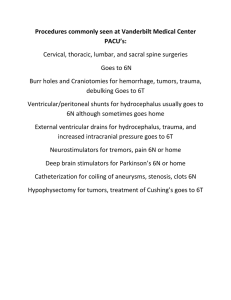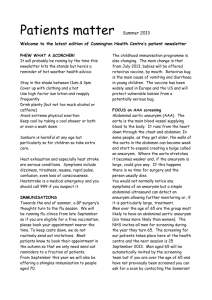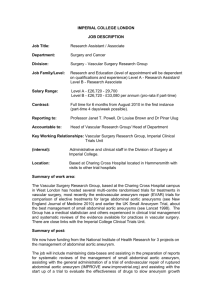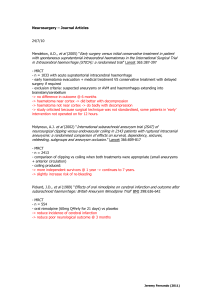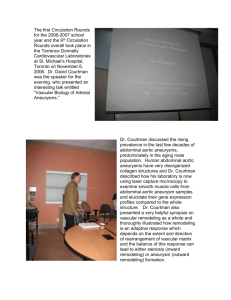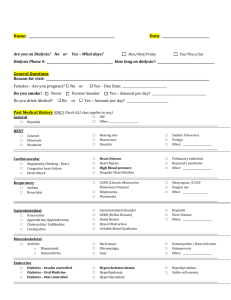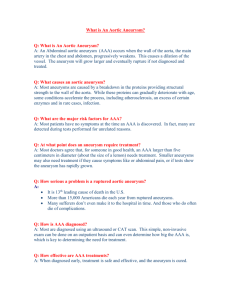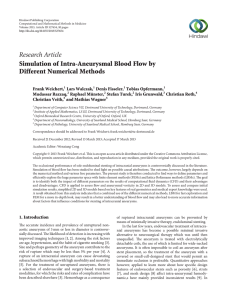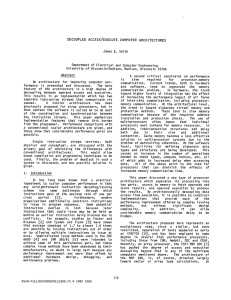Definition & Description
advertisement
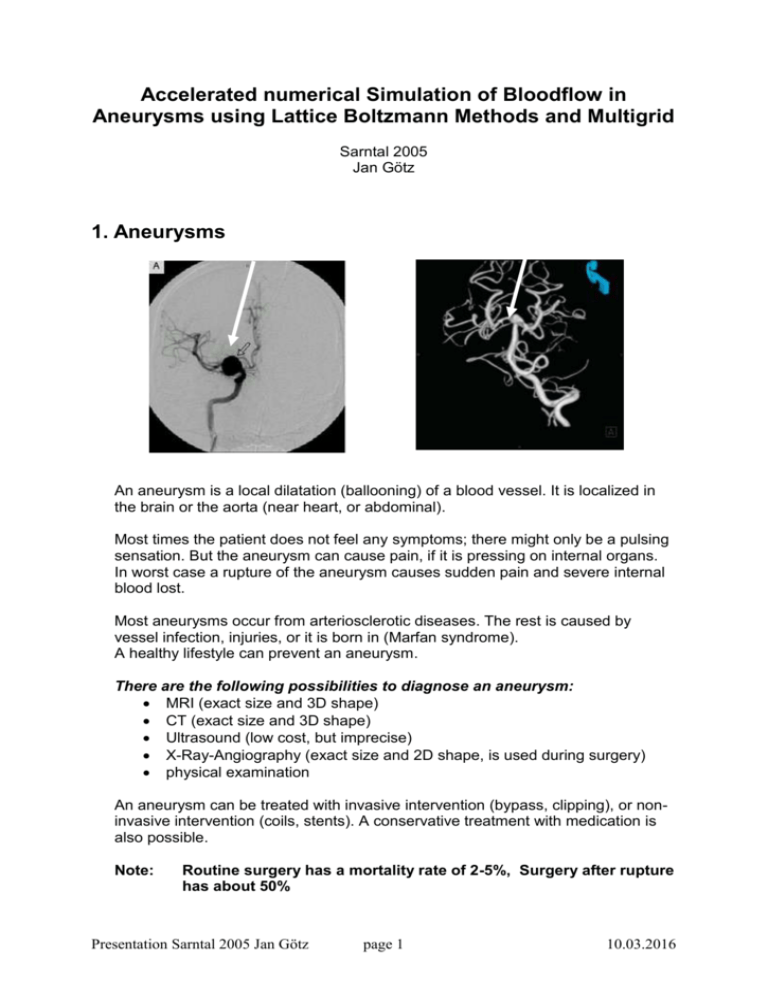
Accelerated numerical Simulation of Bloodflow in Aneurysms using Lattice Boltzmann Methods and Multigrid Sarntal 2005 Jan Götz 1. Aneurysms An aneurysm is a local dilatation (ballooning) of a blood vessel. It is localized in the brain or the aorta (near heart, or abdominal). Most times the patient does not feel any symptoms; there might only be a pulsing sensation. But the aneurysm can cause pain, if it is pressing on internal organs. In worst case a rupture of the aneurysm causes sudden pain and severe internal blood lost. Most aneurysms occur from arteriosclerotic diseases. The rest is caused by vessel infection, injuries, or it is born in (Marfan syndrome). A healthy lifestyle can prevent an aneurysm. There are the following possibilities to diagnose an aneurysm: MRI (exact size and 3D shape) CT (exact size and 3D shape) Ultrasound (low cost, but imprecise) X-Ray-Angiography (exact size and 2D shape, is used during surgery) physical examination An aneurysm can be treated with invasive intervention (bypass, clipping), or noninvasive intervention (coils, stents). A conservative treatment with medication is also possible. Note: Routine surgery has a mortality rate of 2-5%, Surgery after rupture has about 50% Presentation Sarntal 2005 Jan Götz page 1 10.03.2016 pictures of a stent.model (left) and a real stent (right) 2. Numerical Basics 2.1 What is the Lattice Boltzmann method? 1. can be imagined as a type of cellular automaton 2. divide simulation region into a cartesian grid of square/cubic cells 3. each cell only interacts with its direct neighbourhood 4. first order explicit discretization (in space and time) of the Boltzmann equation in a discrete phase space, which describes all molecules with their corresponding velocities Example: D3Q19 is a model for 3 dimensions with 19 velocity-directions 2.2 Equations f 1 1. Collide step f a* ( xi , yi ) f a ( xi , yi ) 2. Stream step f an 1 ( xi hea1 , yi hea2 ) f a* ( xi , yi ) Presentation Sarntal 2005 Jan Götz page 2 n a ( xi , yi ) f aeq ( xi , yi ) n 10.03.2016 How to calculate the equilibrium distribution? 3 9 2 f aeq wa 3ea u u 2 ea u 2 2 eq fa fa u ea f a ea f aeq a a a wi 1 / 3 for i 1 wi 1 / 18 for i 2,7 wi 1 / 36 for i 8,19 a 2.3 Multigrid We use the full approximation storage (FAS) for the nonlinear problem. FAS equations LH uH LH IˆhH uh I hH Rh (uh ) LH uH LH IˆhH uh I hH Rh (uh ) uhn1 uhn I Hh uH IˆhH uhn 2.4 Simplifications a) Blood is a suspension of formed blood cells and some liquid particles in an aqueous solution At high shear rate (γ<100 sec-1) blood can be treated as Newtonian We focus on large vessels → here are high shear rates b) Fluid-structure interaction We neglect the effect of elastic walls. This is reasonable, because in large arteries the effect is quite minor. Additionally, we assume blood as homogenous and incompressible. 3. Simulation 3.1 Goal of the Simulation Recall: Routine surgery has a mortality rate of 2-5%, but a surgery after rupture has about 50%!!! And: Presentation Sarntal 2005 Jan Götz page 3 10.03.2016 The number one cause of death in a developed nation is a heart- or vascular disease → simulations of hemodynamics are very important We want to calculate a time-independent incompressible velocity-field and use this as an initial guess for a periodically forced time-dependent velocityfield 3.2 Why Lattice Boltzmann ? 1. LBM results in an accurate reproduction of the Navier-Stokes-equations, so why NOT ? 2. very complex geometries are readily handled 3. LBM is simple to implement and modify 4. changing the geometry during simulation is possible 5. calculate pressure and other stresses locally in time and space 6. very good parallelization, vectorization and cach-optimazation 3,3 The algorithm f 1 1. Collide step f a* ( xi , yi ) f a ( xi , yi ) 2. Stream step f a** ( xi hea1 , yi hea2 ) f a* ( xi , yi ) 3. Relaxation f an 1 f a** DH 1 f an n a ( xi , yi ) f aeq ( xi , yi ) n DH is called the defect correction How to get the defect correction ??? 1. 1 Rh f f a* ( xi , yi ) 1 f a ( xi hea1 , yi hea2 ) 1 f aeq ( xi hea1 , yi hea2 ) 2. DH RH IˆhH f h 2I hH Rh f h Presentation Sarntal 2005 Jan Götz page 4 10.03.2016

